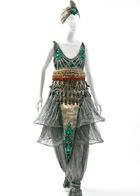
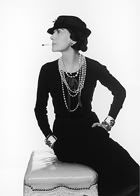


paul poiret, coco chanel, sonia delaunay, elsa schiaparelli
the history of fashion is full of characters that possessed such an unbreakable resolve and unforgiving individuality that their unique and powerful vision not only challenged the tradition of their own respective time, but in the process changed and affected the way everyone will perceive clothes in the future.
not since our early ancestors traded in the loin cloth to be replaced by fabrics early man learned to spin from yarn some five thousand years ago, has fashion changed so radically until the beginning of the twentieth century. although clothes have become more elaborate and the meaning behind it more complex as the centuries went by, clothes were merely something that was used to dictate one's position and place in the world. the corset, the item of clothing that would loom its heavy hood amongst women for over four hundred years have become a necessity. it would've been deemed unmodest, unthinkable even, for a woman to leave her house without one. the practice of wearing these constricting contraptions have become so widespread and so common that by the 1830's it was widely believed that the purpose of the corset was to support the delicate nature of the fairer sex. it was during the victorian era, the time of utmost manners and civility, that the corset saw it's popularity reach its zenith. but it was only a matter of time when a man by the name of paul poiret would change the shape of the female form and as a result, change the face of fashion forever.
the significance of poiret was that he was the first to challenge the status quo. to turn his back on the tradition of wearing a corset that was four centuries old was to create a landslide of free thinkers who was ready to challenge age old ideas of fashion and by doing so revolutionize the way women will dress forever. and there was no other person in history who revolutionized fashion like gabrielle "coco" chanel. the modern women's wardrobe as we know it today owes basically everything from her. she was the inventor of the little black dress, the women's suit, the sport influenced ideas, jersey, menswear influenced fabrics, and costume jewelry to name a few. chanel also popularized the idea of wearing trousers. the audacity she showed as a woman to parade around wearing men's pants at a time when the rules of clothing were extremely segregated between sexes showed the conviction and strenghth of character she possessed. her uncompromising vision, that even now retains its modernity is the greatest legacy she left behind.
the beginning of the century was a fertile time in the art world. invigorated by the triumph of the impressionist, more and more artist seceded from the academic institution of the art establishment and artist continued to develop their own ideas. this was the time when the true meaning of the avant garde came to be.
sonia delaunay was a ukranian born artist who gained fame as part of the school of orphism. an offshoot of cubism that centered its interest into lyrical abstraction using fauvist colours. delaunay was the first artist to use fashion as a vehicle for her art. she applied her trademark cubist influenced patterns into textile design designing women's clothing, the ballet and theatre. gaining enough popularity that her clothes were featured in vogue magazine. she even participated in the now famous exposition interationale des arts decoratifs et industriels modernes", or more famously known as art deco. she paved the way for many artist cum designers such as stephen sprouse. the famous american painter who symbolized the underground art world of new york during the eighties and eventually adapted his talents into fashion design.
the twenties was a time of immense creativity. europe was enjoying a new golden age while america was experiencing its first one. all that was about to change abruptly on october 29, 1929. the day when the sock market crashed and brought about the great depression.
it would seem illogic that it was during the time called the great depression that the woman who would often be referred to as the first avant garde fashion designer would find notoriety and success.
elsa schiaparelli's popularity was by and large a result of her collaborations with surrealist artists such as salvador dali and jean coucteau. among her many famous collaborations was the "shoe hat" that dali had designed for her and the drawing of jean cocteau of two faces kissing to resemble a goblet that she had lavishly embroidered on an evening coat. although she worked with various artists with her designs, she too was capable of delivering her own surrealist tendencies. most notably her drawer jacket which had false pockets to give the illusion of having many compartments akin to that of a dresser. she was also the first to use zippers as a form of adornment, invented the wrap dress four decades before von furstenberg, and was crumpling rayon half a century before issey miyake did and paved the way for designers to use their designs as a blank canvas for artists. a road designers like saint laurent followed when he used mondrian, van gogh, and picasso as elements of his designs. if anyone is looking to blame someone for the now rampant "designer/artist" collaboration...blame schiaparelli.
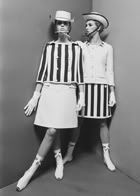
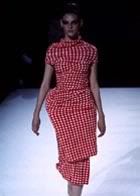

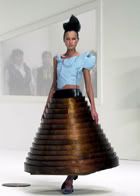
andre courreges, rei kawakubo, vivienne westwood, hussein chalayan

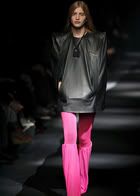
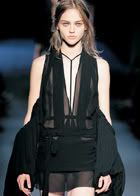

jean paul gaultier, martin margiela, ann demeulemeester, john galliano
the second world war took away the frivolity of fashion and replaced it with uninspired utilitarianism. rationing of materials made it impossible for designers to follow their decadent ideas and after the war and the healing that was to follow the horror of it, an idealistic goal would dominate the collective consciousness of the time. after such a traumatic experience the general mood of the moment was to return to a sense of normalcy and values of the past. dior might have rattled the world with his "new look", but it was in many ways an image that shared similarities with the victorian corseted form. the nipped in waist dior proposed was not the only thing that echoed victorian ideals, the forties and the fifties was also a time of rigid values, and an almost unbreakable social dictum where women stayed home to take care of a house with picketed white fence and where she traded in her corset for a pair of white gloves and a matching hat. although one of the greatest innovators of fashion, cristobal balenciaga flourished during this time, it wouldn't be until the sixties and the youth explosion that the avant garde idea will again take center stage.
trained in the atelier of cristobal balenciaga, andre courreges was the first designers to take fashion where its never gone before...the future. taking inspiration from street culture and the growing symbiosis of music and fashion, correges brought a casual ease to haute couture. adapting the bauhaus theory of movement which meant that function defines form, a mantra that would become the dominating voice in modern fashion, courreges turned away from the restrictive tailoring of his predecessors and moved the clothes away from the body in a highly stylized structural form. and to give more freedom of movement, he raised the hemline up higher that its ever been before, exposing the knee for the very first time.
without courreges and his obsession for the future, one wonders where hussein chalayan would have ended up. just like how the sixties was a time of nervous anticipation for the future, so was the late nineties. entering a new millenium the whole world was pre-occupied with the threat of y2k, global warming, population and then comes hussein chalayan. who showed us that we can simplify our lives even through out clothes. even if that mean turning our coffee table into a dress. for the first time since courreges we finally saw a designer not looking to the past for ideas, but rather into the future.
while the sixties was a time of great advancement, the excess of the seventies in many ways dulled the revolutionary spirit in fashion. it was a time when the age of excess was on the up and the first time when fashion became a popular vehicle to promote someones status symbol. throughout all this a musical movement was about to be unleashed and change the course of not only fashion, but popular culture in general.
the punk movement of the late seventies was the first underground movement to break into the mainstream. with its soldiers marching to the anthems sung by acts the sex pistols, it was the fashion created by vivienne westwood and her then partner malcolm mclaren that would create the uniform for the emerging youth culture. preceding the japanese designers, westwood pioneered the "deconstructionist" aesthetic. ripping pieces of clothing apart and connecting it with safety pins and deliberately tearing clothes to shred as a form of self expression, the punk movement and westwood came to represent a generation of youth who finally realized the harsh reality nobody wanted to face after the second world war. these youths were angry, and they were not afraid to show it, or express it, even through fashion.
it was punk that i believe that inspired the "japanese" aesthetic of deconstruction and reformation. the japanese infatuation for reinterpreting western ideas of clothing is what made them so ground breaking during the early eighties. when rei kawakubo, designer of comme des garcons debuted her collection paris in 1982, the world was to witness perhaps the most influential force in fashion for the past quarter century. a major influence to a group of young belgian designers such as ann demulemeester and martin margiela who would adapt the deconstructionist manifesto and in turn become the new harbingers for the next generation.
amongst a sea of lavish, and ornate ball gowns dripping in embroidery, kawakubo presented clothes that had a post apocalyptic spirit about them. while westwood ripped apart clothing during her punk period, that was all she did. kawakubo however, put them back how she thought it should be. not only was she breaking down the clothes itself, she was in many ways, breaking down our perception of the things we've worn throughout our entire lives. her constant interpretation of western ideals constantly challenges our own beliefs. almost thirty years later, she still remains one of the most important voice in fashion.
over the last decade however, a new breed of mavericks have taken the helm as the new guardians of the avant garde. while galliano now heads one of the most commercial luxury goods label in the world, him, along with jean paul gaultier, were once referred to as fashion's enfant terrible. although now first class designers included in the uber exclusive club of members designing haute couture, the origins of galliano and gaultier owes much to the showmanship of poiret and the artistic sensibility of schiparellli. both have infused street wear and historical research to produce collections that although referenced time that has gone by, have injected it with such modernism by way of global influence. galliano can reference masai beading while gaultier touches on mongolian costumes. pulling different worlds closer to each other by way of fashion. in an incredibly shrinking world thanks to the internet and cheaper plane tickets, the romantic proposition they offer at a time when the whole notion of romance is gone, is perhaps, the most avant garde of all.
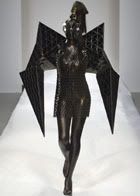


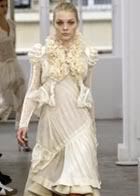
gareth pugh, bernhard willhelm, viktor & rolf, nicholas ghesquiere
the beginning of the new millenium will obviously inspire minds to move towards a new direction. the twenty first century succumbs to that notion. but what makes the beginning of this century different from the one that just passed is this time history is not something to be disclosed but rather be a form of inspiration. that could not be more true at the house of balenciaga. since nicholas ghesquiere took creative control of the house, the once slumbering label has now again been back at the forefront of fashion. in the two thousands, re-interpreting old ideas and finding ways to modernize it has become one of the biggest games in fashion. while ninety percent of these attempts fail in horrible misery, there are designers like nicholas ghesquiere at balenciaga who not only unanimously succeeds, but at the same time becomes the most influential voice of the season.
the same can be said for dutch duo viktor and rolf. their own unique twist on the interpretation of grand traditions is what have made them so successful in their career. it might not be the most commercially understandable clothes, but the ideas they present once diluted becomes a language that breaks through all barriers. which was proven after their highly successful collaboration with swedish retail gian H&M who they designed a capsule collection for in the fall of '06.
fashion however, needs those who can bring new ideas to the table in order to survive. dresses are dresses and pants are pants and for fashion to move forward, it needs new blood willing and able to push the meaning of clothes further into what the general perception of it is. for that, there is no other place to look towards to but london and gareth pugh. where fashion's new enfant terrible is running amock and challenging silhouettes and forms that hasn't been seen since the japanese in the eighties. while london still retains the title as the cradle of the avant garde, antwerp's royal college of art is starting to challenge central saint martins as the nursery for the next most influential designer. running along the same vein as walter van beirendonck, bernhard willhelm bases his collections of pop and underground street culture. creating clothes that in sometimes confusing in its confrontation.
for fashion to continue to be relevant it needs to evolve. in many ways fashion is the only common thread that runs throughout all societies. everyone needs clothes. the importance of the avant garde is that it fosters new ideas. ideas that years from now becomes the norm and fashion needs designers that will take the establishment head on and not be too engrossed with the commerical side of the business, rather than the creative side of it. it is when the public's perception of fashion is challenged and how it ends up adapting and eventually following a new direction is what makes fashion relevant.

1 comment:
Wonderful synopsis. You hit a lot of great points that seem to be glossed over often.
Post a Comment